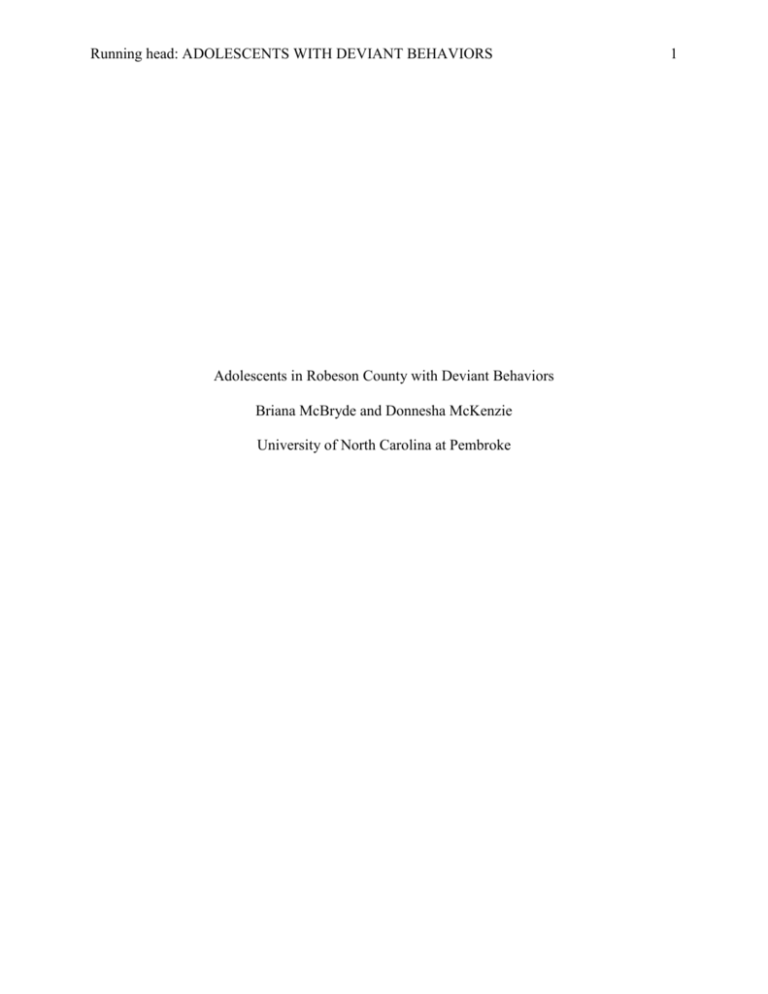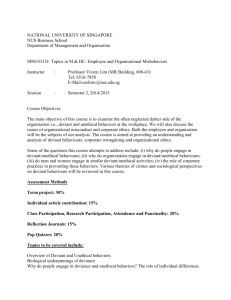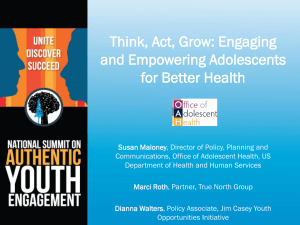Adolescents in Robeson County with Deviant Behaviors
advertisement

Running head: ADOLESCENTS WITH DEVIANT BEHAVIORS Adolescents in Robeson County with Deviant Behaviors Briana McBryde and Donnesha McKenzie University of North Carolina at Pembroke 1 ADOLESCENTS WITH DEVIANT BEHAVIOR 2 Adolescents in Robeson County with Deviant Behaviors According to Newman and Newman (2012), “Adolescence is a thrilling time of life, a time of lasting memories about first experiences”. These experiences can be both positive and negative. Unfortunately, in older adolescents, some negative experiences have recidivated, thus causing a significant increase of problem behaviors in today’s society. The famous Sigmund Freud believed that all behavior has meaning and is motivated. He suggested that behaviors do not occur without a purpose, or occur randomly (Newman & Newman, 2012). Therefore, many factors are connected with how adolescents choose to display negative behaviors. Problem behaviors are those seen as deviant to others not involved in the act, and they usually result in some type of consequence or negative judgment. Influences of peers and siblings can contribute to problem behaviors seen in adolescents. Psychological issues, genetics, and economic disadvantages can play a role in problem behaviors as well. Whether the behaviors are caused by peer pressure, the environment, or psychologically, they vary in a wide range of acts. Some adolescents become bullies, get addicted to sex, abuse drugs and alcohol, and/or commit crimes. Others display their behavior in mental illnesses such as bipolar, posttraumatic stress, etc. Problem behaviors are a huge concern for the individual displaying the act and others that are not involved. This is a problem that needs more awareness. It is becoming extensively familiar in various areas around the globe. In an attempt to save adolescents, solutions to problem behaviors may be found through a variety of resources. The recommended solutions and factors of negative adolescent behavior will be discussed throughout this report. ADOLESCENTS WITH DEVIANT BEHAVIOR 3 Causes of Negative Adolescent Behavior According to Buehler (2006) early adolescence can be characterized as a time of transformation in parent-adolescent relationships. As a result of this, conflict between parents and their developing children escalates; this may serve as a signal to redefine relationships structures and processes. Buehler (2006) states that there are three factors that influence dyadic hostility among youth that includes: inadequate parenting control, parent’s well-being, and youth’s affiliation with deviant peers. Inadequate parenting control includes: inconsistent discipline, psychological intrusiveness, and limited monitoring knowledge (Buehler, 2006). This characteristic may possibly be seen in a parent who may confuse parenting their children and being friends with their children. Also this factor may be an indication of how the parent was raised. Parent’s wellbeing refers to the parent’s individual-level-contribution. This includes the parent(s) life satisfaction, depressive affect, and physical health. Youth’s affiliation with deviant peers is considered an important factor of externalizing problems during adolescence. “Explanations for this association include the ideas that youth might affiliate with deviant peers because they have been rejected by more pro-social peers and that antisocial friendships provide a context for additional training and practice of coercive interactions” (Buehler, 2006, p.110). Carlson (2012) believed that “a parent will directly affect deviant behavior through parenting and the family structure, while indirectly affecting the behaviors through the adolescent’s community, and their choice of peers” (p. 42). Social control or self-control is thought to be an individualistic characteristic that is established early in life and can account for deviant behavior. Self-control can be established through attachments to social foundations. However these social bonds can be weakened and has the ability to influence the level of ADOLESCENTS WITH DEVIANT BEHAVIOR 4 deviance engaged in. Youth who engage in these deviant behaviors do so because it can provide immediate gratification, it requires little thought process, and does not have a long-term goal (Carlson, 2012). As a result of this it is often thought that these adolescents may lack selfregulation, which is the ability to set and attain goals, refrain from problematic behavior, and focus on long-term goals. Sadly the inability to control deviant tendencies will influence the adolescent to partake in deviant behaviors. One consistent causal factor of deviant behavior in adolescents is the parent(s). Children look up to their parents, they observe their every move and whether noticed or not they also imitate/model their parent’s behavior. If a parent exhibits positive behavior then the child is more likely to model that behavior and the same goes for negative behavior. “From birth, a parent will mold and shape behaviors suitable to the norms of society through childrearing” (Carlson, 2012, p. 44). However with the help of parenting techniques such as parental support, parents can show their children that they are valued and loved, which will have a major effect on their upbringing. Through the use of effective discipline, monitoring, and problem solving techniques parents can hopefully develop a system to hinder their child from deviant behaviors. Another factor affecting deviant behavior in adolescents is their environment/community. Durkheim (as cited in Carlson, 2012) argued that deviance is more likely to increase after societies undergo changes that disrupt the community’s social bonds. As a result of this community bonds may weaken and disorganization sets in therefore increasing delinquent behaviors. In agreement, Bronfenbrenner (as cited in Wang & Dishion, 2011) proposed that “An ecological approach posits that the development of adolescent problem behaviors stems from complex and dynamic processes among various social and emotional development”. An adolescent’s development is directly impacted by the system theory of the ecological approach; ADOLESCENTS WITH DEVIANT BEHAVIOR 5 which includes family, neighborhood, and peers. Carlson (2012) states that there are three necessary conditions that a neighborhood must provide for children: monitoring, recognizing deviant behaviors, and punishing the behaviors. When these conditions are met, it reinforces development of normal behavior. Peers are another major factor affecting deviant behavior in adolescents. As an adolescent you want to fit in with the “cool/popular kids” therefore you will do anything to be accepted just as long as you are not ignored or teased. However sometimes that is not always the best decision to make. It is better to be alone then to cause problems for you and your family that will last and/or affect you for a lifetime. Carlson (2012) argues that the age at which an adolescent begins associating with deviant peers influences the level of delinquency the child will participate in. It is important for parents to monitor their child’s friends and academic performances because it can lead to a reduction of deviant behaviors influenced through peers. Three consistent factors that heavily influence deviant behaviors in adolescents include: their parents, environment/community, and peers. When a child lacks the necessary reinforcement, such as effective monitoring and support, they tend to turn towards delinquent behaviors. Research on this topic needs to be done more thoroughly because it can bring awareness to the issue of deviant behaviors and hopefully impact the lives of parents and adolescents for the better. Community Overview According to Blake Tyner of the North Carolina Visitor Center, “the history of Robeson County reaches farther back than its creation in 1787, and reflects the rich history of North Carolina” (Tyner, 2013). Robeson County, containing 948 square miles, is the largest county in North Carolina. The County took its name from Colonel Thomas Robeson, who served in the ADOLESCENTS WITH DEVIANT BEHAVIOR 6 Revolutionary War Battle of Elizabethtown. (Tyner, 2013: NC Visitor Center, 2013) Colonel Thomas is said to have had a great impact on the creation of the county. (Tyner, 2013) According to the 2000 Census (as cited in Richardson, 2005), Robeson County has the ninth largest population of Native American Indians in the United States. (Richardson, 2005) Along with the significant number of Native Americans, the county has often been referred to as tri-racial, which also includes African Americans and Scottish American descendants. Indubitably, it is of the rich heritage within Native Americans that make the County unique. Native Americans in Robeson County have been living in the county before it was established, and they have fought for many rights and equal opportunities. Landmarks and festivals such as the University of North Carolina at Pembroke and the annual Lumbee Pow Wow are evidence of the Native American legacy that lives to this present time. With much similarity of Native American tradition, located in the county is the city of Lumberton. The county seat, Lumberton, was established in 1788. (Tyner, 2009) Approximately 21,542 people live within the 15.8 square mile city limits of Lumberton, North Carolina. More than 16,000 residents are of black and white race, roughly 3,000 Native Americans, and the remaining 2,500 people are of various ethnic backgrounds. The city of Lumberton contains a variety of churches, denomination and nondenomination, a wide array of shopping stores, entertainment establishments, parks and recreation, with many sub-communities surrounding them. Unfortunately, with the many positive places in Lumberton, it simply is not enough to reflect on the county as a whole. Robeson County is currently known as the poorest and one of the most violent counties in the state of North Carolina. Being that the county hospital, Southeastern Health, is located in Lumberton, a majority of the victims and offenders of violent crimes pass through the city. ADOLESCENTS WITH DEVIANT BEHAVIOR 7 According to the Fayetteville Observer, the murder rate in Robeson County is four times the national average and young people in the area are twice as likely to die before the age of 18. (Hixenbaugh, 2011). Being that Lumberton is considered a poor area, a majority of adolescents residing in the city find it challenging to do positive things, are not aware of the available resources, and many have become a statistic in violent behaviors. The Fayetteville Observer reported that recently The University of North Carolina at Chapel Hill was awarded millions of funds to begin the nation’s first violence prevention research center focused on youth in the rural area of Lumberton. (Hixenbaugh, 2011). The Newspaper also stated “the goal of the research project (which is focused on middle school students) is to determine the root of violent behavior in community and to try out programs to combat it” (Hixenbaugh, 2011). With more programs such as these that have efficient funding, a slight change in negative adolescent behaviors will soon appear, thus leading to a decrease in this problem. Interviews Born and raised in Lumberton, North Carolina, Jane McMillan considers herself to be an advocate in her community. Ms. McMillan received her Bachelors in Social Work (BSW) from the University of North Carolina at Pembroke (UNCP). Her current employer is Guardian Ad Litem located in her community where she serves as program supervisor. She has worked there 12 years. Guardian Ad Litem is a program that seeks to serve the best interests of children who find themselves the subjects of court cases by assigning those subjects Guardian Ad Litem volunteers. Ms. Jane has worked with children within the community since 1994; and she frequently comes into contact with adolescents who display deviant behavior. She thinks the issue occurs ADOLESCENTS WITH DEVIANT BEHAVIOR 8 frequently due to many reasons. One reason is that parents are younger; children today are having children at the young ages of 10-11 years old. She also thinks that the issue is so prevalent because society has changed, there is no family support, no trust in communities, and she considers society to be immature. She states that when she began to have kids, she could always depend on her mom or someone from the community to help her out (J. McMillan, personal communication, October 25, 2013). Today this has become less likely because with changing times, you can no longer trust other people with your children. Even though success stories are rare today, Ms. Jane feels as though her efforts within the community have initiated positive change. There are a few kids in particular that she talked about frequently and feels as if they are her greatest accomplishments. With the help of Ms. Jane they realized that the sky is the limit; some are first generation graduates and others have joined the Air force and Army. Her motto is “education before recreation”. However during years 20072008 Ms. Jane feels as if her success rate has dropped. Kids are no longer motivated. She feels as if they want to change but they lack the courage to do so. When asked how severe do you think the problem is in Lumberton, with a serious face she replied “very severe” (J. McMillan, personal communication, October 25, 2013). She supports this opinion based on the facts that statistics for Robeson County are very high. More specifically the statistics are high in STD/AIDS, dropout rates, and Robeson County was just recently recognized as the poorest county in North Carolina. Another factor she considers important is that majority of these kids have been exposed to sexual abuse, physical abuse, suicide, bullying, substance abuse, etc. With all these factors building up against these kids it is important that they have positive role models in their lives; someone who is going to reassure and believe in them. Some ADOLESCENTS WITH DEVIANT BEHAVIOR 9 things that she has done to help this issue are to stay active in the kid’s lives. She always promotes the program because there is a strong need for it in the community. She states that through collaboration, consistency, believing and having faith, and community service it will alleviate some of the prevalence of deviant behavior among adolescents (J. McMillan, personal communication, October 25, 2013). She states that there are plenty of resources available within the community and even Robeson County to help these adolescents (J. McMillan, personal communication, October 25, 2013). They include: the boys and girls club, Colors of life, Parkview recreation, local churches, colleges such as Fayetteville State University (FSU) and Robeson Community College (RCC), smart start (for five years olds), 4-H Club, boys/girls scouts, public housing, etc. A program that she really feels makes a difference in the community is the 4-H club mostly because of how active they are with the kids. Ms. Carlita Brewington has worked as a juvenile court counsel for 13 years. Ms. Brewington supervises juvenile delinquents that have been put on probation and she also has the power to judge (i.e. decide to go to court, rule a case out). She works closely with kids of Robeson County but sometimes she has to travel depending on where the child is located. Ms. Brewington has lived in Lumberton all of her life and she thinks this issue is getting worse. Children are being disciplined less and becoming more fearless. While doing this job she has had many success stories, but she states that it is mostly based on the individual; whether they want better for themselves or not (C. Brewington, personal communication, October 25, 2013). In her opinion she thinks that staying involved and holding kids accountable for their actions helps them to change for the better. She also thinks of her career as more than just a job, you have to care about the kid’s overall wellbeing. Over the years ADOLESCENTS WITH DEVIANT BEHAVIOR 10 she has come to the conclusion that no matter how hard you try there are just some people that you cannot help, so her motto has become “if you can save one then at least you know you made a difference somewhere”. Some resources she utilizes for the kids she works with include: multipurpose home (group home placement/therapeutic), Port Human Services (used for juveniles), Eckard (therapeutic/in-home), and mental health agencies such as Department of Social Services (DSS). Robeson County native, Mr. King has lived on the Westside of Lumberton, NC for over twenty years. He currently works in the emergency department of Southeastern Health as a certified nurse assistant/ transporter. While on the job, Mr. King stated, “I witness at least thirty adolescents be admitted for psychiatric evaluation per week” (King, personal communication, October 31, 2013). King has the opportunity to work closely with the nurse and doctor that treat these adolescents, and often has in depth conversations with the young, trouble individuals. Mr. King reports “the problem with these kids come from lack of guidance” (King, personal communication, October 31, 2013). Frequent deviant behaviors displayed by the adolescents consist of drug overdose/ abuse, alcohol intoxication, and harming themselves by cutting. King has also seen victims of domestic and sexual abuse on various occasions. Through conversation Mr. King has learned most adolescents that come to the facility live in one parent homes and do not have curfews. This is lacking of disciplinary skills and could be a sign of poor attachment/ bonding between the child and parent. Mr. King usually steps often finds himself acting as a role model. He gives adolescents encouraging words and direction toward positive activities around the community that they may want to consider after treatment. “Positive activities like recreation teams would help these kids a lot” (King, personal communication, October 31, 2013). King believes that by kids involving ADOLESCENTS WITH DEVIANT BEHAVIOR 11 themselves in these type activities they will feel a sense of belonging and a change in adolescent behavior would soon come. (King, personal communication, October 31, 2013). Assessing Resources and Gaps Various organizations and groups are available in Robeson County for adolescents who display deviant behaviors. The Haymount Institute for Psychological Services provides assistance to families experiencing problems, and it seeks to find solutions to these problems by teaching the patient to attain new skills and goals. Similar to this institute is Associate Behavioral Services. This program is primarily based on mental health and substance abusing patients; providing service to all who wish to obtain a better life. Many of Robeson County residents begin their journey to a better life through admitting themselves to the hospital, Southeastern Health. At the hospital residents are assessed and referred to places such as the Haymount Institute for Psychological Services, Associate Behavioral Services, and age-based mental facilities within North Carolina. If one chooses not to involve themselves in costly facilities he/she has an option to seek assistance within support help groups such as the Odum Home, Haymount United Methodist, Palmer Drug, and Guardian Ad Litem. These non-profit services provide for adolescents or have systems specifically designed for the adolescent population. Additional resources that target adolescents within Robeson County are the boys and girls club, colors of life, 4-H Club, and Parkview recreation. These programs do not necessarily accommodate “deviant” adolescents, but they play a substantial role in preventing deviant behaviors from coming to reality. The previous listed programs are needed to keep adolescents positively occupied while out of school. With more recreation type resources available, Robeson County should see a reverse in troubled adolescents. While researching the course of deviant ADOLESCENTS WITH DEVIANT BEHAVIOR 12 adolescent behaviors, two hypotheses come to mind; lack of resources and lack of parental guidance. As stated previously in the literature review Carlson (2012) assumed that “parents affect their children’s behavior through family structure and parenting”. Without the adequate amount of parental guidance, one is bound to travel the wrong path. Economical disadvantages are a main factor in behavioral issues seen in adolescents. Robeson County neighborhoods show a lack of consistency while comparing to less problematic neighborhoods. Carlson (2012) stated a neighborhood must monitor, recognize, and punish deviant behaviors. It seems as Robeson County lies far past this tactic and it is too late to try this type of reinforcement. Expansion of recreational programs may be the best option to save our adolescents. The ability of the community to meet and/or address the needs of deviant behavior in adolescents is far from being solved. Adolescents have several stereotypes and obstacles they need to overcome such as the high crime and dropout rate. However change cannot be made over night, this issue is longstanding and will require time and dedication. Weaknesses facing this community include: people who prevent/oppose change for a number of reasons, few monies to initiate and keep a steady program, kids/parents not being knowledgeable and/or barriers to adequate resources, the longstanding history of the effects of deviant behavior, etc. Strengths of this community include: programs such as Parkview recreation and Colors of Life, prominent figures in the community striving for change, juvenile system (instead of punishing kids they reinforce their behavior and try to get to the root of the problem), local churches working within the community, afterschool programs, etc. There are plenty of resources within this community that people can utilize to elicit change among these kids. The problem lies in the fact that many people just simply do not know ADOLESCENTS WITH DEVIANT BEHAVIOR 13 these resources are available until the problem becomes severe and result in things like jail or death. Furthermore the bulk of the responsibility also lies with the parents; they must stay active and become positive role models for their children from birth to adulthood. Overall with more awareness to these programs and parents taking on the expected responsibilities, change in deviant adolescent behavior is likely to come. Adolescents in Robeson County need people that care. Although some may lack parental guidance, they would still be able to seek guidance from others in the community. ADOLESCENTS WITH DEVIANT BEHAVIOR 14 Resources Buehler, C. (2006). Parents and peers in relation to early adolescent problem behavior. Journal of Marriage and Family, 109-124. Carlson, A. (2012). How parents influence deviant behavior among adolescents: An analysis of their family life, their community, and their peers. Perspectives (University of New Hampshire), 42-51. Hixenbaugh, M. (2011, January 5). Robeson County is the most violent in state. The Fayetteville Observer. Retrieved from http://www.fayobserver.com Newman, B. M. & Newman, P. R. (2012). Development through life: A psychosocial approach. Belmont, CA: Wadsworth Cengage Learning. Richardson, G. A. (2005). The State and its Tribes. North Carolina Museum of History , 45 (1), 1-3. Tyner, B. (2009). NC GenWeb. Retrieved from http://www.ncgenweb.us/robeson/history.htm Tyner, B. (2013). NC Vistior Center. Retrieved from http://ncvisitorcenter.com/Robeson_County_history.html Wang, M.-T., & Dishion, T. J. (2011). The trajectories of adolescents’ perceptions of school climate, deviant peer affiliation, and behavioral problems during the middle school years. Society for Research on Adolescence, 22(1), 40-53.







